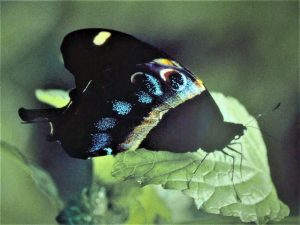‘Holy Grail’ butterflies are those rare, remote, hard-to-find, attractive species that linger in the imagination. For me, the holiest of grails for many years beginning in my childhood was the Jamaican Giant Swallowtail (Papilio homerus). It was more like a myth than an actual species – seen by few and living in only two isolated and diminishing locations in the remoter rainforest of the Caribbean island, Jamaica.
To add to its mystique, it is considered the largest butterfly in the western hemisphere and is one of the most endangered life forms on the planet, being listed on Appendix I (the most at risk) of the Convention on International Trade in Endangered Species of Flora and Fauna (CITES). It is one of only four butterfly species listed there. Its other common names are the Homerus or Homer’s Swallowtail because it is named after Homer, the famous Greek author of the mythological Odyssey and the Iliad.
I had visited Jamaica several times in the 1970s and 80s (including camping there on my extended honeymoon in 1972). However, I had not had the opportunity to travel to where it flies in either of its rugged and remote Jamaican locations; the wild and inaccessible Cockpit country in the west or where the Blue and John Crow Mountain ranges meet in eastern Jamaica, its stronghold.
In June 1992, I met up in Kingston with Dr. Tom Turner, a noted Jamaican lepidopterist and author of many articles on the biology of homerus. He and I travelled Jamaica for a week. We decided to start our search by driving south from Port Antonio on the northeast coast and travelling up alongside the Rio Grande River into the John Crow Mountains. As the road proceeded into the foothills it became little more than a rutted, pot-holed track crossed by ravines choked with dense rainforest. We spent two days in the “Maroon” village of Millbank where in colonial times the slaves ran away to establish remote communities. The annual rainfall in this region is up to 700 cm a year. The nearby Blue Mountains are almost always covered in clouds and the area, including the homerus habitat, is now part of the Blue and John Crow Mountains National Park.
In the Millbank region, we had surprisingly sunny weather and I had the opportunity to watch huge homerus adults on the wing as they flapped and soared, often well above our heads, up and down the streams along which grew their larval foodplant, Water Mahoe (Hernandia catalpaefolia). One particularly large female landed on a leaf at eye level and, although shaking with excitement, I managed to snap a few photos. A life-time dream fulfilled. We also met up with Dr. Eric Garraway who was researching the homerus life history and were lucky enough to see and photograph a very large, green homerus caterpillar munching on an oversized Water Mahoe leaf.
Jamaica has adopted the Jamaican Giant Swallowtail as the symbol of its efforts to conserve its native habitats and endemic life forms. Its picture has appeared on paper money and stamps and it features in many conservation educational programs for the island’s school children. It is also protected in law by the Jamaican government and the local residents actively monitor for any poaching.
As Dr. Turner and I continued our travels around the island we came across many other Jamaican butterflies, including five other endemic species and subspecies of swallowtails (a highlight being the threatened Jamaican Kite Swallowtail (Eurytides marcellinus) at one of its few known breeding colonies). As well, we found many hairstreaks, blues, sulphurs, brushfoots and skippers. We also visited the dangerous karst habitat, with its deep limestone pits, in the Cockpit country. While finding several other endemic butterflies, we encountered no further Jamaican Giants.
I am now pleased that eButterfly has introduced the ability to enter my historical records from Jamaica and other locations in the Caribbean, Mexico and Central America. It will bring back many memories of times spent in this fascinating part of the world.
